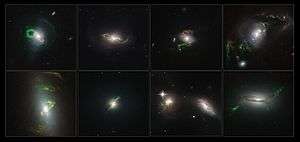Photoionization
Photoionization is the physical process in which an ion is formed from the interaction of a photon with an atom or molecule.[2]

Cross section
Not every interaction between a photon and an atom, or molecule, will result in photoionization. The probability of photoionization is related to the photoionization cross-section of the species, which depends on the energy of the photon (proportional to its wavenumber) and the species being considered. In the case of molecules, the photoionization cross-section can be estimated by examination of Franck-Condon factors between a ground-state molecule and the target ion. For photon energies below the ionization threshold, the photoionization cross-section is near zero. But with the development of pulsed lasers it has become possible to create extremely intense, coherent light where multi-photon ionization may occur. At even higher intensities (around 1015 – 1016 W/cm2 of infrared or visible light), non-perturbative phenomena such as barrier suppression ionization[3] and rescattering ionization[4] are observed.
Multi-photon ionization
Several photons of energy below the ionization threshold may actually combine their energies to ionize an atom. This probability decreases rapidly with the number of photons required, but the development of very intense, pulsed lasers still makes it possible. In the perturbative regime (below about 1014 W/cm2 at optical frequencies), the probability of absorbing N photons depends on the laser-light intensity I as IN .[5] For higher intensities, this dependence becomes invalid due to the then occurring AC Stark effect.[6]
Resonance-enhanced multiphoton ionization (REMPI) is a technique applied to the spectroscopy of atoms and small molecules in which a tunable laser can be used to access an excited intermediate state.
Above-threshold ionization (ATI)[7] is an extension of multi-photon ionization where even more photons are absorbed than actually would be necessary to ionize the atom. The excess energy gives the released electron higher kinetic energy than the usual case of just-above threshold ionization. More precisely, The system will have multiple peaks in its photoelectron spectrum which are separated by the photon energies, this indicates that the emitted electron has more kinetic energy than in the normal (lowest possible number of photons) ionization case. The electrons released from the target will have approximately an integer number of photon-energies more kinetic energy.
Tunnel ionization
When either the laser intensity is further increased or a longer wavelength is applied as compared with the regime in which multi-photon ionization takes place, a quasi-stationary approach can be used and results in the distortion of the atomic potential in such a way that only a relatively low and narrow barrier between a bound state and the continuum states remains. Then, the electron can tunnel through or for larger distortions even overcome this barrier. These phenomena are called tunnel ionization and over-the-barrier ionization, respectively.
See also
References
- "Hubble finds ghosts of quasars past". ESA/Hubble Press Release. Retrieved 23 April 2015.
- IUPAC, Compendium of Chemical Terminology, 2nd ed. (the "Gold Book") (1997). Online corrected version: (2006–) "photoionization". doi:10.1351/goldbook.P04620
- Delone, N. B.; Krainov, V. P. (1998). "Tunneling and barrier-suppression ionization of atoms and ions in a laser radiation field". Physics-Uspekhi. 41 (5): 469–485. Bibcode:1998PhyU...41..469D. doi:10.1070/PU1998v041n05ABEH000393.
- Dichiara, A.; et al. (2005). "Cross-shell multielectron ionization of xenon by an ultrastrong laser field". Proceedings of the Quantum Electronics and Laser Science Conference. 3. Optical Society of America. pp. 1974–1976. doi:10.1109/QELS.2005.1549346. ISBN 1-55752-796-2.
- Deng, Z.; Eberly, J. H. (1985). "Multiphoton absorption above ionization threshold by atoms in strong laser fields". Journal of the Optical Society of America B. 2 (3): 491. Bibcode:1985JOSAB...2..486D. doi:10.1364/JOSAB.2.000486.
- Protopapas, M; Keitel, C H; Knight, P L (1 April 1997). "Atomic physics with super-high intensity lasers". Reports on Progress in Physics. 60 (4): 389–486. Bibcode:1997RPPh...60..389P. doi:10.1088/0034-4885/60/4/001.
- Agostini, P.; et al. (1979). "Free-Free Transitions Following Six-Photon Ionization of Xenon Atoms". Physical Review Letters. 42 (17): 1127–1130. Bibcode:1979PhRvL..42.1127A. doi:10.1103/PhysRevLett.42.1127.
Further reading
- Uwe Becker; David Allen Shirley (1 January 1996). VUV and Soft X-Ray Photoionization. Springer Science & Business Media. ISBN 978-0-306-45038-9.
- Cheuk-Yiu Ng (1991). Vacuum Ultraviolet Photoionization and Photodissociation of Molecules and Clusters. World Scientific. ISBN 978-981-02-0430-3.
- Joseph Berkowitz (1979). Photoabsorption, photoionization, and photoelectron spectroscopy. Academic Press. ISBN 978-0-12-091650-4.
- V. S. Letokhov (1987). Laser photoionization spectroscopy. Academic Press. ISBN 978-0-12-444320-4.